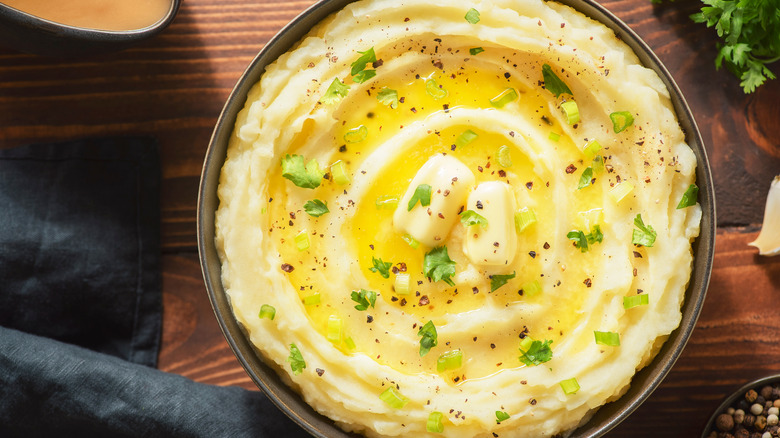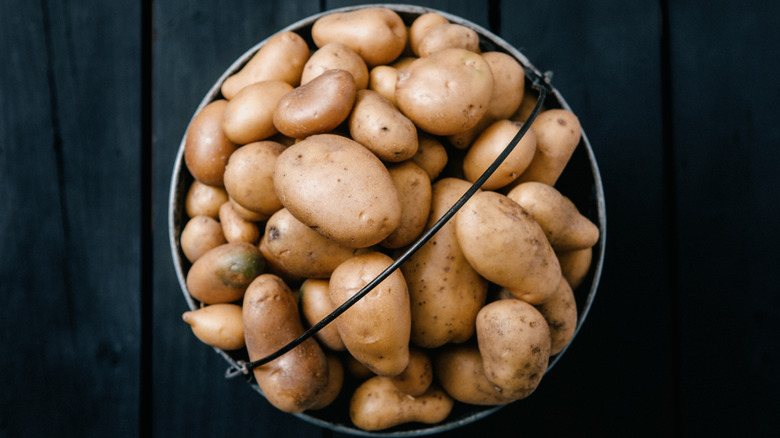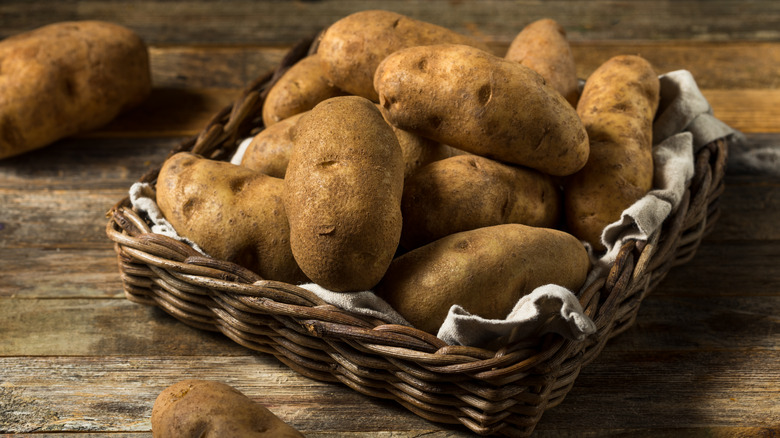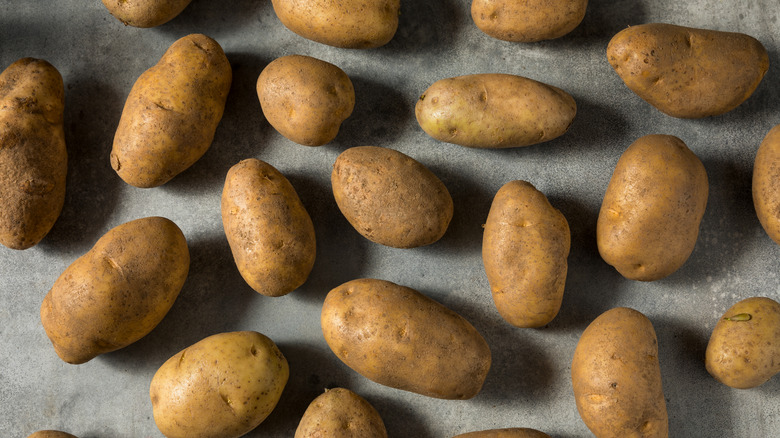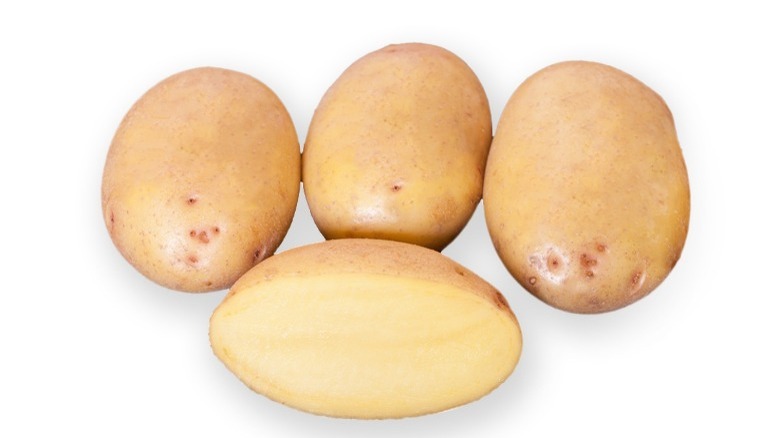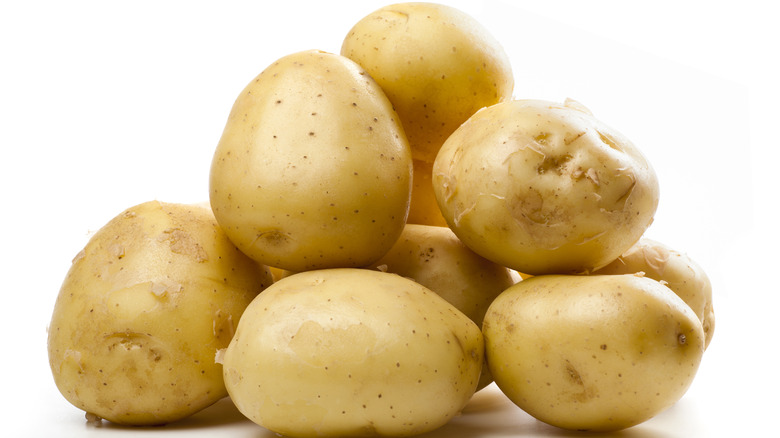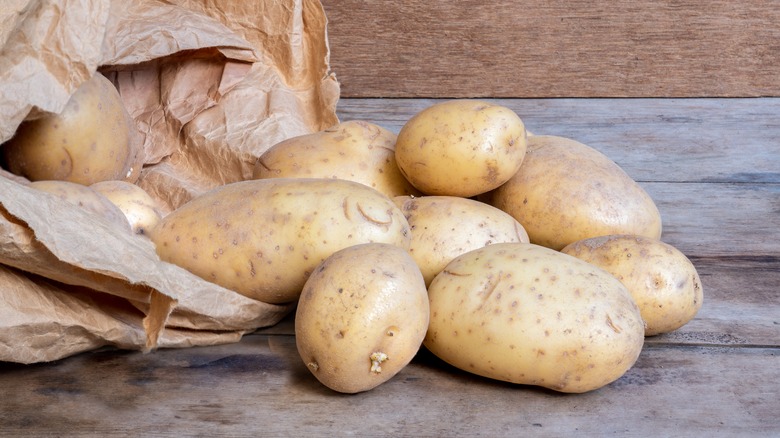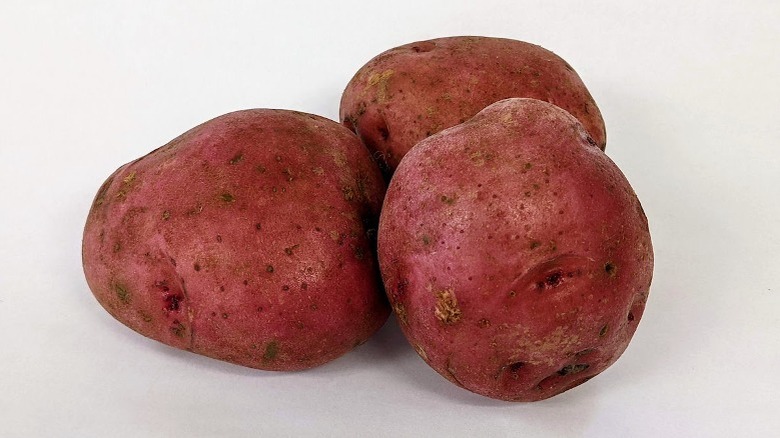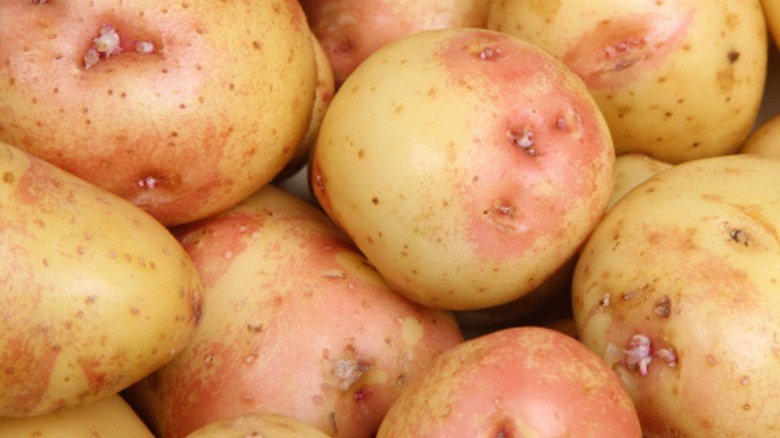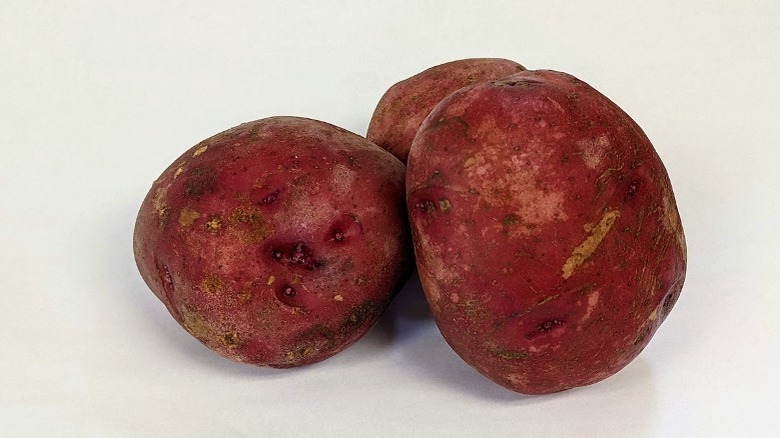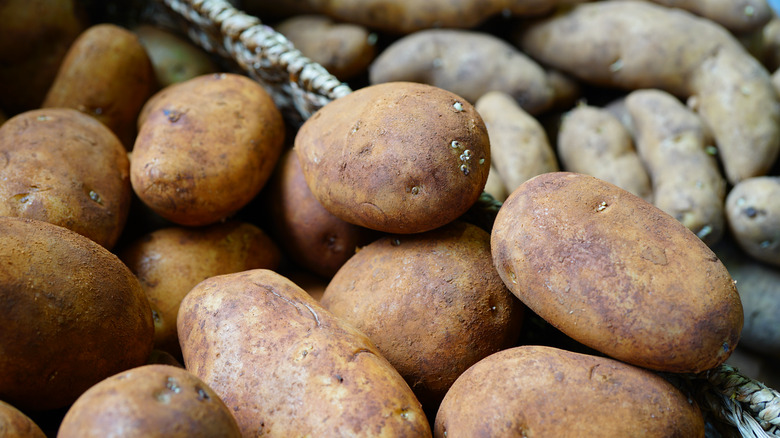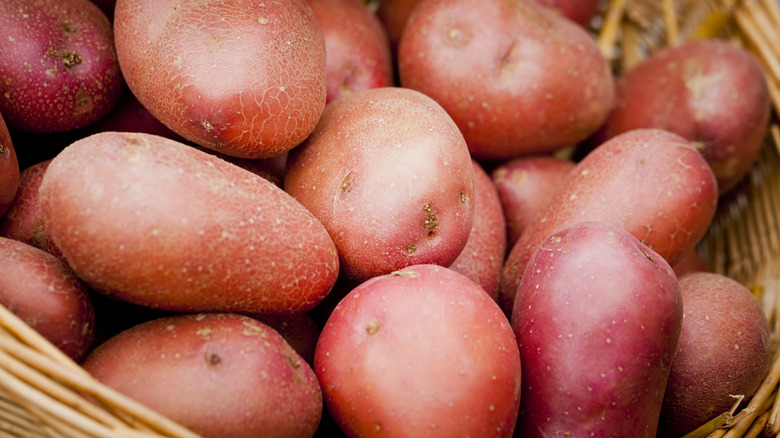13 Best Potato Varieties To Use For Mashed Potatoes
Show us a person who doesn't like mashed potatoes. You can't, can you? This perennially tasty side dish is beloved the world over and offers a perfectly fluffy, creamy counterpart to an endless array of main courses. However, while mashed potatoes are simple to make and even simpler to eat, your choice of potato variety can affect the texture of your mash in some quite surprising ways.
Potatoes generally fall into two different categories: Waxy and starchy. Waxy potatoes are defined by having a lower starch content and higher overall moisture, and this combination tends to produce a mashed potato that's creamy and thick. Conversely, starchy potatoes are lower in moisture and higher in, that's right, starch, and this creates a fluffier, more buoyant mash. The texture of your potatoes can also affect how well they take on additional ingredients like cream and butter, which give your mash added flavor.
However, here's the good news, folks: Both types of potato can produce excellent mash. The secret is not so much whether you pick a waxy or a starchy variety, but what type of each you pick. And we've got every great-for-mashing variety you'll want to know, right here.
1. Yukon Gold
In the world of mashable potatoes, the Yukon Gold reigns supreme. This potato, with its golden-yellow flesh and light-brown skin, is available at virtually every supermarket in the country, and its availability paired with its culinary excellence makes it a top choice for mashing. You should use Yukon Golds for mashed potatoes because they combine starchiness with a rich, buttery flavor. This means that they maintain a light, airy quality when mashed, while still tasting distinctive and creamy.
The Yukon Gold also has a moisture advantage over other potatoes, as it doesn't take on water as readily as some other varieties. This means that mash made with Yukons is less likely to become waterlogged and mushy. Their visually appealing color also makes the mash they produce a dream to look at, perfect for placing a pad of butter in the center and watching it melt in. These potatoes are also excellently versatile and can take on the flavors of additional ingredients readily. Try Yukon Gold mashed potatoes with roasted garlic for an instant crowd-pleaser full of savory goodness.
2. Russet
Russet potatoes commonly feature on lists of potatoes that make mashed 'taters, and we're not about to buck the trend. These potatoes are full of starch and have very low moisture levels. As such, when you mash them, they break down super easily, creating a light, bouncy mash that takes on additional liquids and fats, like cream and butter, really well. There's no need to stir them endlessly to incorporate additional ingredients or to break them down further — and because the moisture content is already low, you don't need to worry too much about them becoming soggy.
It's useful to point out, however, that while russets may win on the texture front, they can often use a little help flavor-wise. An easy way to rectify this is by using additional seasoning or adding in extra ingredients to give them depth. The key to the best mashed potatoes, however, is using different types of spuds in the same dish. A combination of russets and Yukon Golds can work perfectly here. Yukon Golds are waxier but have a more distinctive, buttery flavor, and this can help to give your russet mash extra richness and a little more body.
3. Idaho
For mash, you can't go wrong with a good, old-fashioned Idaho potato. The northwestern state is well known for its potato production, and russet potatoes are often grown there. It's important to note, though, that there is a difference between the tubers that can be dubbed as "Idaho potatoes" and russets themselves. Russets are grown in Idaho, sure, but they're also grown in other parts of the country, and a host of other varieties are often grown in the state, as well. Idaho potatoes — you guessed it — are those grown Idaho, which has particularly favorable growing conditions for quality potatoes.
So, if you're buying Idaho potatoes at the store, you may not be getting a russet, but what you will be getting is a potato that's perfect for mashing. Idaho potatoes commonly have a high starch content, and this makes them ideal for making fluffy mash that resists being waterlogged. To make mashed Idaho potatoes, it's as simple as boiling them in a pot, draining them well, and then mashing them up. However, if you want to make a super-light, airy mash, bake your potatoes for an hour before scooping out the insides and mashing them. Doing this will help keep them as dry as possible, allowing you to then add extra moisture in the form of cream or milk, making them ultra-creamy.
4. Nectar
Nectar potatoes might not be the most common variety out there, but if you can find them, they make excellent mash. These potatoes are great all-rounders and have a fair level of starchiness, making them good for a mash that's not too dense, while also having a creaminess to them that helps to give the mashed potatoes a bit of weight. We're also a really big fan of their buttery flavor, as this allows you to not have to add too much additional fat to your mashed potatoes.
As such, Nectar potatoes are the perfect choice for folks who are trying to keep their potatoes relatively low-fat, or those who prefer not to eat butter. If you want to, though, you can load them up with plenty of butter and give them extra richness. Nectar potatoes also have a pleasing mid-yellow color, which produces a perfect-looking mash, and their relatively thin skins make them easy to prepare. These potatoes can be slightly less commonly found in the United States, and you're more likely to find them if you're in the U.K. or Ireland — but if you run into them at a specialty food store, don't hesitate to try them out.
5. Georgina
You can't go wrong with Georginas. Georgina potatoes are exactly what you picture when you think of a classic, mashable potato, with smooth, golden skin and a vibrant yellow flesh that makes picture-perfect mash. Their combination of a buttery, smooth texture and a dairy-esque flavor makes them the perfect choice for folks who like their mashed potatoes relatively unadorned, and even without the addition of cream or butter, they'll still be delicious.
That's not to say that they can't take extra flavors, though. Georgina potatoes have a light nuttiness to them that both sets them apart from other potatoes and allows them to hold their own when you add more ingredients. To allow these nutty notes to come through, try throwing in some extra parmesan with your Georgina-based mash. Not only is it an ingredient that boosts the texture of your mashed potatoes, bringing extra body to the mixture, but it will also add some nutty layers that deepen the overall flavor profile. A touch of truffle oil can also add some incredible taste dimensions to mashed potatoes made with Georginas, giving them some serious savoriness.
6. Maris Piper
Maris Pipers may not be as common in the U.S. as other potato varieties, but if you're ever making your mash in the United Kingdom, it's a tuber you can rely on. This British potato variety is almost absurdly good for mashing. Maris Pipers have an ultra-high starch content, which allows them to avoid being too heavy or gummy when they're broken down. Instead, these 'taters produce a pillow-like softness and have a lightly floury consistency and flavor that lends itself well to copious amounts of butter.
Maris Pipers also have a beautiful light-golden hue to them, which gives your mashed potatoes that classic look. As a small bonus, these potatoes are often pretty massive, allowing you to avoid having to fiddle around with peeling tiny ones to make your mash. Although this is primarily a British potato variety, that doesn't mean that you can't find it in the U.S. — although tracking them down can be tricky. Maris Piper seeds can be subject to shipping restrictions, so they're far less common in America, although they can occasionally be found at farmer's markets and in specialty food stores when in season. If you can't find these potatoes, though, just swap them out for russets.
7. Chieftain
You wouldn't think that a potato with such a fancy name would produce the best rustic, homestyle mash out there, would you? Well, that's the joy of Chieftains — they continue to surprise. These potatoes are one of the best red varieties out there for mashing. They have a beautifully creamy flavor and texture, which makes any mash made out of them rich and luscious.
The true selling point of mashed potatoes made with Chieftains, though, is their skins. When you leave them on, they produce a mash that's studded with flashes of bright red skin. This gives you a mashed potato dish that isn't just visually striking but has a deeper flavor, with way more nuttiness. The skins also give the mash a slightly chewy texture, while the creamy, soft potatoes hold everything together. It is important to remember, though, that red potatoes are on the waxier end of the spectrum, so you'll want to be sparing with how much you mash them to ensure they don't turn gluey. Breaking them down too much will also cause the red skins to sort of disappear into the mixture, and instead, you want them to hold their own in contrast to the white flesh.
8. King Edward
With such a regal name, you can expect King Edward potatoes to be pretty tasty — and they certainly are, especially when you're making mash with them. King Edward potatoes are most commonly seen in the United Kingdom, where they've been one of the most common types since 1902, when they were named after King Edward VII following his coronation. If you look hard enough, though, you'll find them in the U.S., where they've been seen in some farmer's markets and specialty shops. You can also buy their seeds online if you're inclined to grow them at home.
So, what makes King Edwards good for mashing? Their fluffiness. King Edward potatoes are pretty starchy, and this helps to keep them from retaining too much moisture when they're cooked and mashed. It also means that they're able to take on extra liquids, like cream or whole milk, without getting gloopy. If you want mashed potatoes with a little extra character, try keeping their skins on. King Edwards have a light pink skin that can give your mash pops of rosy-hued interest and a little extra bite in each mouthful.
9. Norland
Norland potatoes can make your mash look pretty special. These red potatoes bring a lot of contrast to the table: A dynamic-looking 'tater, they're distinguished from other red potatoes by their darker red skins and their bright white flesh, making skin-on mash that looks as good as it tastes. Their lower starch content, meanwhile, makes a mashed potato dish that's smooth and moist.
When preparing Norlands for mashing, though, you need to follow a few basic steps. Because they, like all red potatoes, have a higher level of moisture inside them, it's a good idea to drain them super well before allowing them to air dry slightly. This can help to prevent any unwanted moisture from making its way into your mixture, as once it's in, it's hard to get rid of. It's also always wise to hold off on adding any butter, cream, milk, or stock until your potatoes are fully mashed. That way, you'll be able to determine how much extra moisture they can feasibly take before they get gloopy, and whether you're better off just adding some salt and pepper for additional flavor.
10. Dutch Cream
It's hard to go wrong with Dutch Cream potatoes for your mash. Dutch Creams have a bright yellow flesh that makes any mashed potato dish you make with them pop with color and vibrancy. The "cream" in their name refers to their flavor, which is unusually buttery and rich, giving you way more bang for your buck and stopping you from having to add endless amounts of dairy to amp them up.
Although these potatoes are on the waxy side, don't let that put you off: What they lack in premium fluffiness, they make up for with a smooth taste. However, if you want to make them the best they can be, an extra step in your mash preparation will help. Instead of boiling your potatoes, prick them all over and then roast them. You know those little bubbles that appear at your fork holes when you do this? That's water evaporating from the potatoes. When you roast Dutch Creams, you help to diffuse excess moisture, making them drier and fluffier when mashed, while retaining their deep, buttery flavor.
11. Desiree
We're a big fan of Desiree potatoes, y'all. Desiree potatoes are a red-skinned variety, with the ruby-red coating encasing a creamy yellow flesh. These potatoes grow big and hardy, giving you plenty of bang for your buck and limiting the need to fiddle around with tiny, wrinkly tubers to get your mash. Most important, though, is their flavor. Desirees have a delightfully creamy taste and a similarly creamy consistency, and when the two are combined, you end up with a mash that's full of character. They're also not too waxy and instead have a balance of waxiness and flouriness, which is fairly rare for a red potato.
Finding Desiree potatoes in the United States may be slightly tricky, although not impossible. This variety is way more common in the United Kingdom and across parts of Europe, particularly in Italy, where they're highly popular. In America, you might be more likely to find them in local outfits, as opposed to on supermarket shelves. We'd thoroughly recommend growing Desirees at home, though: They're reliable tubers that don't take much work to cultivate successfully.
12. Rooster
Rooster potatoes don't just have a great name — they make great mash. A red-skinned variety, Rooster potatoes are a highly versatile tuber, and as well as being good for making fries or roasting, they also make excellently fluffy mashed potatoes. Unlike some other red varieties, Roosters have a floury consistency, which means that when mashed, their flesh remains relatively dry and bouncy.
For this reason, they're an excellent potato to try if you've previously written off red potato skin mash. Some people who aren't fans of this mash style have turned away from it due to its relative gumminess, but when using Roosters, you get a fluffy mashed potato dish that's studded with chewy, flavorful skins. The flesh also contributes to the flavor, thanks to its innate creaminess. The trick to making mash with Rooster potatoes is using plenty of butter and cream; this helps to amp up their flavor and give them a luscious quality. Don't be shy about throwing in more than you think you need, folks — the extra fat can help to lubricate those potato skins and stop them from becoming too mealy.
13. Katahdin
Katahdin potatoes are great for a lot of things, but they're particularly good for mash. These potatoes have thin skin, white-yellow flesh, and an excellent balance of fluffiness to creaminess. When mashed up, this creates potatoes that are light and airy, while still having a good amount of bulk to them. Katahdins are also pretty large, which is helpful if you don't want to peel a load of tiny potatoes and just want to chunk up one or two.
Katahdins' thin skins are particularly useful if you're making skin-on mashed potatoes, as they'll add a good amount of texture without being difficult to handle or overly fibrous. They also have a delicious potato-y flavor, with a richness balanced with slight earthy tones. This flavor profile can work well with loads of different additions, but if you want to honor the flavor of the Katahdin potato, make some classic buttery mashed potatoes. Here, the butter helps the Katahdins sing and smooths out any unnecessary earthiness. The added fat also gives the potatoes extra body and makes them way more filling.
